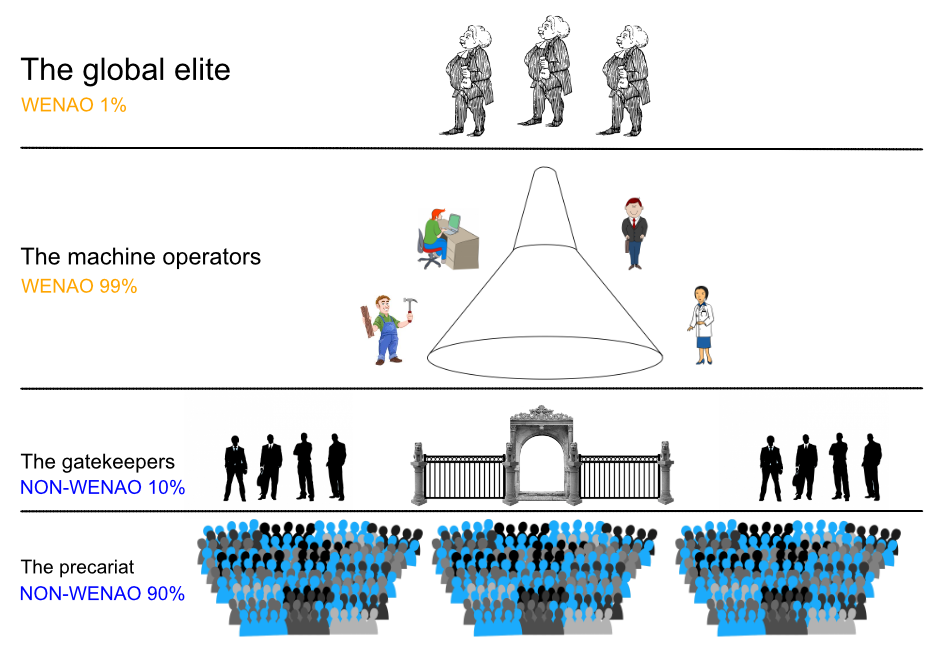The Current State Of The World
There are many ways to analyze the current state of the world. However, one aspect stands out as the most influential, the economic state. What work you do, what you eat, what recreational activities are available, how safe are you day to day; all this is determined by where you fit into the global economic system. What's more you may be surprised to hear that you probably don't understand this system nor how your day job fits into the greater process.
TL;DR (Too Long Didn't Read) - The global system has become amazing at harvesting the surplus generated by the large majority of poor and vulnerable people. You (likely) directly support this exploitation in your day job, in fact this is the primary reason for the quality of life you enjoy. Democracy or a lack of it has little to do with this parasitic relationship. It is due to first world corporations and governments actively facilitating the exploitation of poor people from around the world. Further more, the majority of the wealth generated goes not to you, but to the ultra rich and is why those in first world countries can still struggle to make ends meet.
Let's drill into the wealth breakdown and how this economic process functions.
The WENAO Countries

WENAO (Western Europe North America Oceania + Japan) countries are the OECD countries that joined up to 1973 before a ~20 year gap to more countries joining. They represent the wealthiest countries that in terms of total household wealth have benefited the most from globalization. Notes on the data
As we can see those in WENAO countries have much more wealth per person.
This Isn't The Full Picture
This simplifies things into 2 main groups, however in actuality there are 4. Let's drill into the wealth distribution of the WENAO and non-WENAO countries.
Note: 1% = 1% wealthiest people in a given bracket. 99% = The rest. Same with 10% v 90%.
Obviously there is a considerable degree of inequality. These stats may or may not make that clear. The non-WENAO poorest 90% (78%) of the worlds population have just 4.0% of the wealth. The top 1% in WENAO countries make up 0.13% of the worlds population but have 41% of the wealth.
Let's Make This Clearer
The four brackets in the graphs above actually represent the 4 key groups in the global economic system. Let's drill into this.

The Precariat
The non-WENAO 90% makes up 78% of the worlds population. Not all (but a large majority) of these people can be considered in the precariat.
The Precariat: Attributes
- Globally they are on very low pay.
- They have little to no ability to negotiate on wages or conditions.
- Loss of employment could be life threatening or result in permanent homelessness.
- * They are forced into the global system of production.
The Global Elite
The global elite are the primary benefactors of globalization as they are able to harvest the vast majority of the surplus that the precariat generate. The actual global elite is a small fraction of the top 1% (which is households with more than $871,000 USD).
The Global Elite: Attributes
- Primarily based in WENAO countries.
- They are owners, not employees.
- They use their wealth to influence government policy.
- They use tax loopholes to avoid a large amount of tax.
- They have media influence.
The Machine Operators
The global elite, which are a tiny fraction of the worlds population, cannot manage the process of harvesting the surplus of the precariat by themselves. A large number of people are required to manage the logistics, hardware and software necessary for this process.
The Machine Operators: Attributes
- Primarily based in WENAO countries.
- Have skills through a good education.
- Are paid enough to live well and accumulate a small amount of wealth.
- May not work directly for the global elite, but in ancillary roles eg. health care.
The Gatekeepers
The gatekeepers manage the precariat and "bring them online" into the global system. The global elite aren't in a good position to manage this process as they don't have a local presence in many of these countries, nor is particularly desirable as the profit to be made is relatively low compared to their main businesses.
The Gatekeepers: Attributes
- Based in non-WENAO countries.
- Owners of factories and service centers made up of the precariat.
- Not excessively wealthy as the global market to employ the precariat is highly competitive.
Those in the first world tend to not understand this greater process, nor the reasons as to why it persists. What do most people believe?